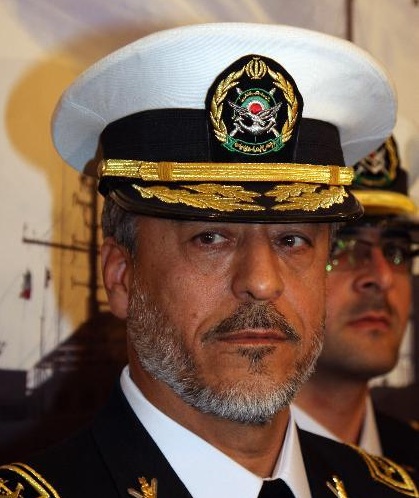February 14-2014

. . . won’t say what’s up
by Warren L. Nelson
A senior Iranian naval officer announced Saturday that two Iranian warships had entered the Atlantic Ocean on their way to the “US maritime border,” but three days later the commander of the Iranian Navy said that was erroneous.
Rear Admiral Habibollah Sayyari, the commander of the Navy, told reporters Tuesday that the two ships dispatched three weeks earlier to the Atlantic Ocean were actually sailing in the Gulf of Aden and were more than 2,500 miles (4,000 kilometers) from the Atlantic.
Sayyari said the two ships would return to Iran in the months after Now Ruz on March 21. He did not say whether or not the ships would venture into the Atlantic in the meantime. There is plenty of time for them to do so.
On January 21, the Navy announced that two ships had left Bandar Abbas that day and would sail around the southern tip of Africa into the Atlantic Ocean and then proceed to sail near the United States.
On Saturday, Admiral Afshin Rezai-Haddad said the ships had rounded the Cape of Good Hope and were in the Atlantic. What struck some as odd was that Rezai-Haddad is the commander of Iran’s warships in the Caspian Sea and thus has nothing to do with the ships that set sail from Bandar Abbas. Based on what Sayyari said Tuesday, Rezai-Haddad didn’t know what he was talking about.
But it was odd that ships dispatched three weeks ago to the Atlantic were nowhere near the Atlantic yet and that Sayyari didn’t say they would head there. That suggested the Rohani Administration might have objected to the planned deployment as provocative and a bad thing to do while Iran is trying to negotiate a nuclear agreement with the Americans.
It now remains to be seen if the two ships will sail across the Atlantic to the edge of the United States, or sail briefly into the Eastern Atlantic thousands of miles from the United States, or just sail around the Gulf of Aden for two months and before returning home.
The reaction from the United States to the announcement that the ships were in the Atlantic was varied. A few journalists who clearly knew nothing about the military portrayed the ships as a major threat to US national security.
Others more astute pointed out that the Russians have sailed ships with nuclear weapons up and down the US coasts for decades.
Some portrayed the Iranian deployment as simply laughable. Forbes magazine called it a “comic relief mission” and said, “You have more to fear from your bathtub boats than from this ostensible armada.” It said, “Iran’s gunboat diplomacy” more likely would expose how “feeble” its threat really is because its “fleet” is comprised of two small, aging and poorly armed vessels.
The US Navy treated the announcement with a shrug. Navy officials pointed out that navies have the right to sail anywhere in international waters and even to make “innocent passage” through national waters. They pointed out that the US Navy has ships not far off the Iranian coast and Iran has the very same right to sail ships off the US coast.
One US Navy spokesman said that if the Iranian Navy does enter the Atlantic, “they should not be surprised to find many other navies also sailing in the Atlantic” as dozens of nations have warships there.
If the US Navy has an argument with Iran it is over the fact that the Pasdaran have repeatedly said the United States has no right to sail in international waters of the Persian Gulf while Iran is now claiming the right to sail immediately off the US coast—in effect saying it has a right to do what it says the United States has no right to do.
The two Iranian ships are the Sabalan, a 45-year-old British-built ship that the US Navy bombed and heavily damaged in 1988, and the Kharg, also an aging vessel built by Britain. Iran’s calls the tiny Sabalan a destroyer, though it is actually the size of a much smaller frigate. It calls the Kharg a helicopter carrier, though it is actually a supply ship. The Sabalan is armed with four Chinese anti-ship missile launchers and a single 4.5-inch gun. Kharg carries three helicopters for delivering supplies.
Andrew Cordesman of the Washington-based Center fro Strategic and International Studies (CSIS) told CNN: “To people who don’t know anything about sea power—which is a fairly substantial number of people in the developing world—it looks like a major gesture. Within Iran’s sort of politics, it follows a long theme of … statements that Iran can defeat the United States.”
But Cordesman said, “Deploying a military museum is not going to threaten to the United States.”
He said, “Iran can sort of make demonstrative gestures and sail in international waters off the US East Coast—or West Coast, for that matter. But it’s not much more threatening than if somebody showed up in a rowboat.”
Iran first announced its intention to sail ships into the Atlantic in July 2011, almost three years ago. Then in September 2011, Sayyari said Iran would station ships “near the maritime borders of the United States…. Like the arrogant powers that are present near our maritime borders, we will also have a powerful presence close to the American maritime borders.”
